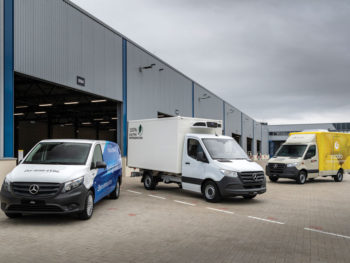Mercedes-Benz Vans is making it easier for bodybuilders to work with its vans and chassis, says Dan Gilkes.
 The Mercedes-Benz Sprinter is a truly global van, built at plants in Dusseldorf in Germany, Buenos Aires in Argentina and North Carolina, USA. When it comes to chassis cabs however, the company’s centre of production is in Ludwigsfelde, near Berlin. The site has been building various Mercedes models for more than 50 years, but took control of Sprinter chassis production in 2006. It now assembles single and double cab chassis cabs in various lengths and weights, along with a recently added tractor head, which is basically a chassis with the lower part of the cab that is primarily built for motorhome conversion.
The Mercedes-Benz Sprinter is a truly global van, built at plants in Dusseldorf in Germany, Buenos Aires in Argentina and North Carolina, USA. When it comes to chassis cabs however, the company’s centre of production is in Ludwigsfelde, near Berlin. The site has been building various Mercedes models for more than 50 years, but took control of Sprinter chassis production in 2006. It now assembles single and double cab chassis cabs in various lengths and weights, along with a recently added tractor head, which is basically a chassis with the lower part of the cab that is primarily built for motorhome conversion.
The site’s 2,000 staff build more than 200 Sprinter chassis each day, in a modern facility that features augmented reality headsets for picking parts, automated guided vehicles for component delivery to the line and exoskeletons for assembly line workers, to reduce physical stress when operating with heavy components and assembling overhead.
The facility also features a Bodybuilder Centre, to make it easier for converters and bodybuilding companies from across Europe to collaborate with Mercedes. Body solutions are designed and engineered here and validated and approved for sale. There is also a bodybuilder portal, providing the latest technical detail, which is currently being used by more than 4,000 bodybuilders, from 90 countries.
The current Sprinter, the third generation of Mercedes’ large van range, offers models from 3.5-5.5 tonnes gross weight. There are front-, rear- and all-wheel drive models available, plus the addition this year of the eSprinter full electric range, which will join the recently launched eVito in the Mercedes-Benz Vans line-up.
Approved bodybuilders are split into two groups under the Mercedes system. Mercedes-Benz VanPartner vehicles are sold through dual invoice transactions, with the chassis and body conversion ordered separately. Approved bodybuilders provide a separate warranty for the conversion.
The second level of partnership is called Mercedes-Benz VanSolution, where vehicles can be assembled and supplied ex-works, with a single invoice and warranty. In effect these are Mercedes’ Ready to Work products in the UK, which can be supplied complete from a dealer. The line-up currently includes dropsides, tippers and Luton bodies.
However, the Bodybuilder Centre and the wide range of conversion companies are developing far more than these three models. At a recent event at the Ludwigsfelde plant, bodybuilders including the UK’s VFS and Paneltex offered an overview of just some of the diverse range of conversions on offer.
The most interesting van on show for many wasn’t actually on a Sprinter base. The Arctic Fox concept, from German converter Kerstner, was based on the electric eVito. The van has an insulated refrigerated body capable of making up to 50 deliveries in a single shift. Unlike some competitors, which have been trying to use additional power sources to drive the refrigeration unit, the Arctic Fox uses the van’s traction battery to power the cooling unit.
The concept has already undergone a four-week trial with a meal kit provider called HelloFresh, in Belgium. It offers three operating modes to guarantee temperature stability in the cargo area. The refrigeration unit can be powered from the mains when the vehicle is stationary, powered by the traction battery on the move and uses a small buffer battery when making deliveries.
Mercedes-Benz Vans also demonstrated a range of last-mile parcel delivery solutions, a number of minibus bodies, various tipper and dropside utility vehicles, aerial work platforms, temperature-controlled vehicles and motorhomes at the event. At present around 80% of the chassis built at Ludwigsfelde go to external bodybuilders for conversion work to be carried out.

